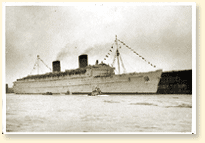

Passenger liner RMS Queen Elizabeth docks in Halifax with returning troops |
The Canadian Armed Forces: Demobilization
As the war drew to a close, members of all the armed forces of the wanted nothing so much as to shed their uniforms, and fast.
But there was not enough shipping available to bring Allied troops
from all over the world as quickly as they wished. Both the and the Canadian concocted complicated systems
for deciding when their members could "demob" - get out and get
home. Length of service, marital status and peacetime job were all
part of the mix, and those who volunteered for further duty in the
war against Japan were told that they could home before anyone else.
The general rule, though, was "First In - First Out." Units which
had trained and fought together were not necessarily to stay
together for the trip back to Canada, although some did. The Irish
Regiment of Canada, memorably, came home to parade a last time in
Toronto. Some squadrons intended for the Pacific war flew their
Lancaster bombers back to Canada. 3rd Canadian Infantry Division, by then made up of men with low
priority for returning home, was part of the occupation force in
Germany until the spring of 1946. After VE Day, both transport
and bomber squadrons of the carried food supplies to the starving
Dutch population ( see The Liberation of the Netherlands, 1944-1945 )
and brought freed Allied prisoners of war and returning servicemen
to Britain. A strike among RCAF groundcrew impatient to be back
in Canada made people at home suddenly aware that some Canadian
squadrons were still in England in 1946. Equipment, like service personnel, had to be demobilized. Aircraft
of the were sold for civilian use, recycled or even piled up
and burned. Armoured vehicles sold overseas became agricultural or
construction machinery. The 's multitude of small escort vessels
were sold off or recycled as scrap metal; a few of the best went
into storage. Related Newspaper Articles
English Articles
- Power Forecasts Demobilization
The Toronto Daily Star, 06/10/1944
- 35 000 Men Scheduled For Occupation Force; Discharge 65 000 Fliers
The Globe And Mail, 30/05/1945
- First In - First Out
The Globe And Mail, 06/06/1945
- 1 000, Convoy Vessels Join 'Boneyard Fleet'
The Globe And Mail, 13/06/1945
- Crerar Orders Troops To End All Bickering
The Hamilton Spectator, 12/07/1945
- Claim First In, First Out Policy Not Being Followed
The Hamilton Spectator, 18/07/1945
- Admit Policy Unfair, 'Too Late' to Change It
The Globe And Mail, 21/11/1945
- Flyers Refuse To Work Until Requests Met
The Hamilton Spectator, 06/02/1946
- Gibson Promises Demobilization Of RCAF Sept. 30
The Globe And Mail, 28/05/1946
- Three Famous Fighting Regiments Return To Toronto Today
The Toronto Telegram, 16/01/1946
French Articles
-
Dans l'armée canadienne. Une indemnité de réintégration civile
Le Devoir, 04/01/1941
-
Réintégration dans la vie civile
Le Devoir, 02/10/1941
-
Au Sénat. La réintégration des soldats dans la vie civile
Le Devoir, 22/07/1942
-
L'armée canadienne veille sur le soldat
Le Devoir, 28/08/1942
-
M. Ian Mackenzie parle du rétablissement des démobilisés dans la vie civile
Le Devoir, 11/03/1943
-
Secours et réhabilitation d'après-guerre
Le Devoir, 09/11/1943
-
Que ferons-nous de nos démobilisés?
Le Devoir, 24/12/1943
-
Nouvelles de guerre. La rentrée des troupes amène la diffusion de la syphilis
Le Devoir, 08/09/1944
-
Le colonel Ralston répond à nos soldats d'Italie
Le Devoir, 03/10/1944
-
Nouvelles de guerre. Aviateurs démobilisés et fin du recrutement du C.A.R.C.
Le Devoir, 06/10/1944
-
Le problème de réhabilitation
Le Devoir, 14/11/1944
-
Militaires de retour
Le Devoir, 21/11/1944
-
Pour aider la réhabilitation
Le Devoir, 21/11/1944
-
Militaires canadiens arrivés au pays
Le Devoir, 27/12/1944
-
Programme de démobilisation dans l'aviation canadienne
Le Devoir, 29/05/1945
-
Combattants canadiens qui reviendront au pays
Le Devoir, 30/05/1945
-
Plans de démobilisation annoncés par M. King
Le Devoir, 01/06/1945
-
La démobilisation au service naval
Le Devoir, 15/06/1945
-
Le retour à la vie civile pour les marins
Le Devoir, 22/06/1945
|